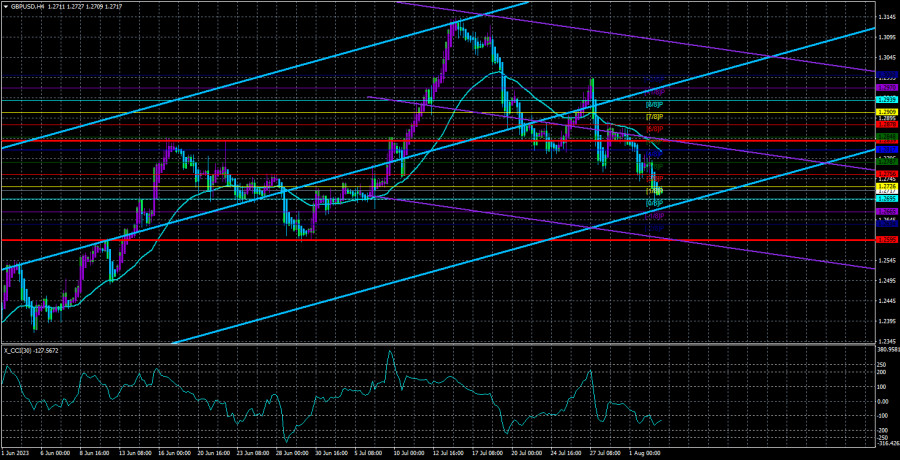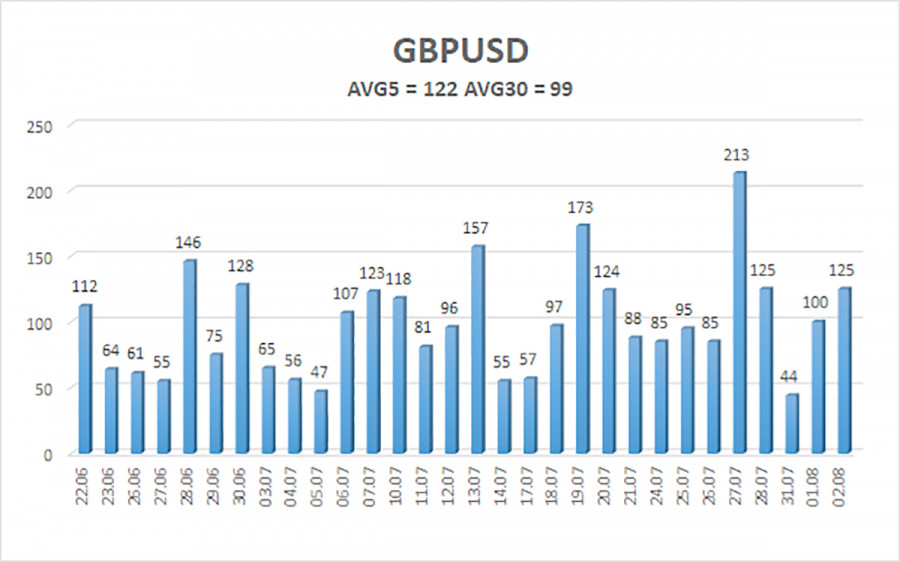

The GBP/USD currency pair continues its decline. The ADP report from the USA primarily influenced the drop yesterday, but the connection is superficial. It's important to remember that today, the Bank of England's meeting results will be announced, and there is a 100% probability of a 0.25% interest rate hike for the fourteenth consecutive time. Given the current inflation level in the UK, it's clear that the British regulator has no alternative but to continue tightening. However, a few months ago, we questioned how much further the Bank of England could raise rates. After all, its options are not unlimited! If the interest rate becomes too high, it could seriously contract the economy, requiring further stimulus measures. This might lead to new QE programs similar to those seen post-pandemic.
In our view, the Bank of England has already approached the maximum possible interest rate. First, the market had enough time to anticipate all possible tightening measures. As we can see, it didn't waste time - the pound rose almost 3,000 points in the last ten months, while the Federal Reserve also raised rates during this period. Currently, the Fed's rate is higher than that of the Bank of England. Yet, even now, the question of why the dollar fell so sharply over the past year remains open. In attempting to answer this question, we believe the pound soared too high, so it should now fall regardless of the news background. If this is the case, any further rate hikes by the Bank of England will no longer positively impact the pound.
The Bank of England might signal a pause or the end of the rate hike cycle. The Bank of England has been, is, and will remain a "dark horse." The information from its corridors is so scarce that concluding its future actions is very difficult. Representatives of the ECB and the Federal Reserve speak almost every day, providing comments on their views of monetary policy and its prospects. In comparison, Bank of England representatives speak once a week at best. So, we won't be surprised if the British regulator raises rates by 0.5% for the second time today.
However, the market has already priced in a specific scenario of possible events. The baseline scenario assumes a 0.25% rate increase, which has already been accounted for. As the pound has fallen in recent weeks, we believe the market interprets a quarter-point rate hike as "dovish." If this is the case, we might witness a temporary rise in the pound today, but it's unlikely to last long.
If the Bank of England raises rates by 0.5%, the British currency could experience significant strength. However, if Andrew Bailey hints at a possible pause or talks about reaching the peak rate value, it could drive the pound much lower than its current position. As we can see, there are several potential scenarios, and as the last meeting showed, surprises can be expected from the British regulator. The vote on the rate will also be significant. There are nine members of the monetary committee, and seven of them consistently vote for a rate hike. If their number decreases today, it could also be a reason for the pound to decline.

The average volatility of the GBP/USD pair over the last five trading days is 122 points, considered "high" for the pound/dollar pair. On Thursday, August 3rd, we can expect movement between 1.2595 and 1.2839. An upward reversal of the Heiken Ashi indicator will signal a phase of upward correction.
Nearest support levels:
S1 - 1.2695
S2 - 1.2665
S3 - 1.2634
Nearest resistance levels:
R1 - 1.2726
R2 - 1.2756
R3 - 1.2787
Trading recommendations:
On the 4-hour timeframe, maintaining short positions with targets at 1.2665 and 1.2595 is still recommended until the Heiken Ashi indicator shows an upward reversal. Alternatively, considering long positions becomes viable if the price is confirmed above the moving average, aiming for targets at 1.2878 and 1.2939.
Explanation of illustrations:
Linear regression channels - help determine the current trend. If both channels are directed in the same direction, it indicates a strong trend.
Moving average line (settings 20.0, smoothed) - determines the short-term trend and the direction in which trading should be conducted.
Murray levels - target levels for movements and corrections.
Volatility levels (red lines) - the probable price channel the pair will trade in the next day, based on current volatility indicators.
CCI indicator - its entry into the oversold area (below -250) or overbought area (above +250) indicates that a trend reversal is approaching in the opposite direction.